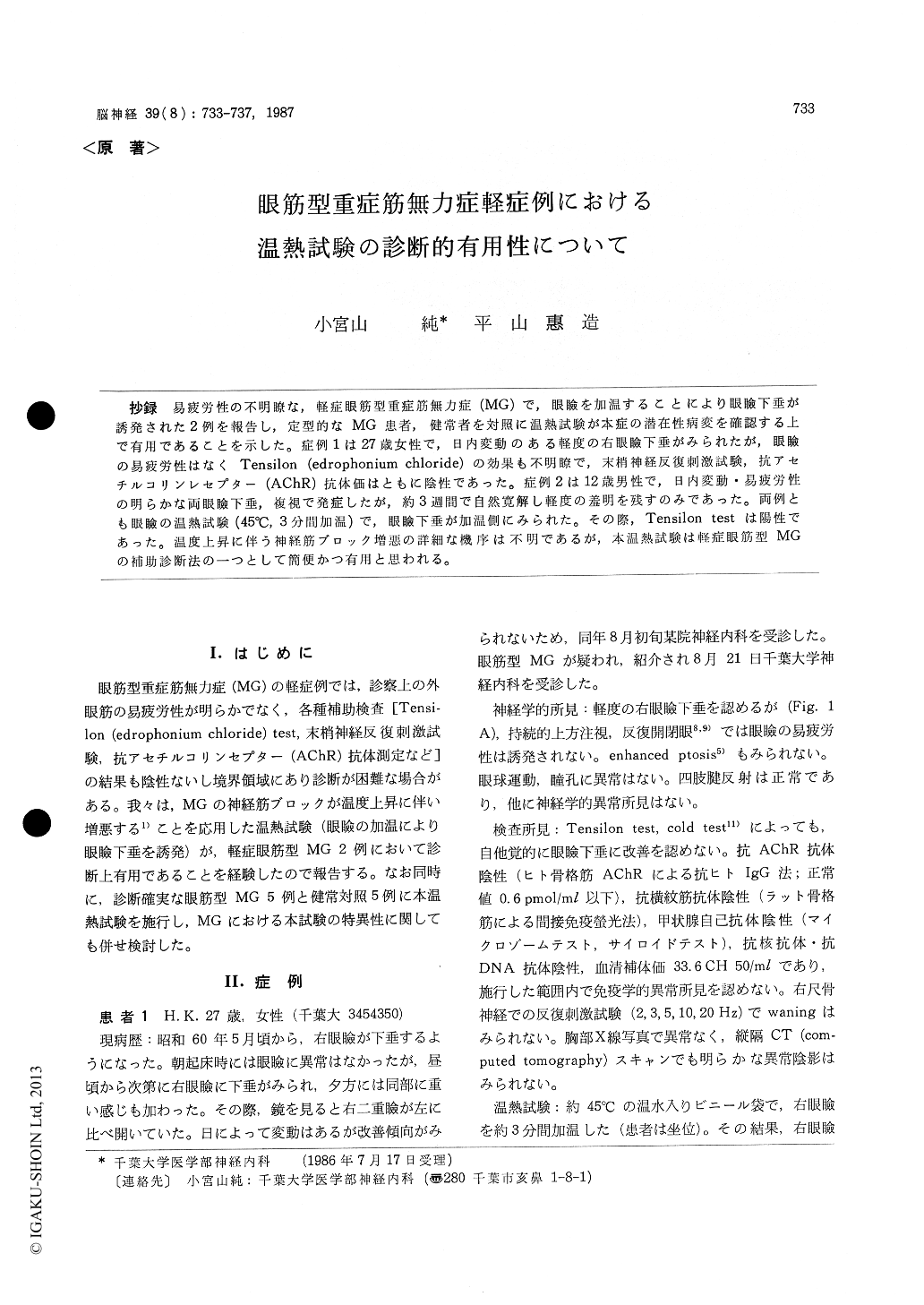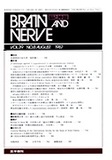Japanese
English
- 有料閲覧
- Abstract 文献概要
- 1ページ目 Look Inside
抄録 易疲労性の不明瞭な,軽症眼筋型重症筋無力症(MG)で,眼瞼を加温することにより眼瞼下垂が誘発された2例を報告し,定型的なMG患者,健常者を対照に温熱試験が本症の潜在性病変を確認する上で有用であることを示した。症例1は27歳女性で,日内変動のある軽度の右眼瞼下垂がみられたが,眼瞼の易疲労性はなくTensilon (edrophonium chloride)の効果も不明瞭で,末梢神経反復刺激試験,抗アセチルコリンレセプター(AChR)抗体価はともに陰性であった。症例2は12歳男性で,日内変動・易疲労性の明らかな両眼瞼下垂,複視で発症したが,約3週間で自然寛解し軽度の羞明を残すのみであった。両例とも眼瞼の温熱試験(45℃,3分間加温)で,眼瞼下垂が加温側にみられた。その際,Tensilon testは陽性であった。温度上昇に伴う神経筋ブロック増悪の詳細な機序は不明であるが,本温熱試験は軽症眼筋型MGの補助診断法の一つとして簡便かつ有用と思われる。
The diagnosis of myasthenia gravis (MG) can usually be made on the basis of the characteristic clinical history and signs, improvement by the use of anticholinesterase drugs, decremental re-sponses in repetitive nerve stimulations, and assay of anti-acetylcholine receptor (AChR) antibody titers. We, however, have difficulty to make dia-gnosis of ocular MG patients with mild symptoms because muscular weakness is minimal and ancil-lary tests are negative. In the present communica-tion, we report clinical usefulness of a hot test to provoke ptosis by warming the eyelid in ocularMG patients with minimal fatigability.
Patient 1, a 27-year-old housewife, developed drooping of the right upper eyelid in May 1985. The ptosis was absent in the morning, but became apparent and worsened later. Neurological exami-nation carried out 3 months after the onset reveal-ed mild right ptosis, but fatigability of the levator palpebrae superioris could not be elicited by the provocative procedures such as sustained upward gaze or repeated opening and closing of eyelids. Both Tensilon and cold tests yielded negative responses. Repetitive nerve stimulations produced no decremental responses. Titers of anti-AChR antibody and antistriational antibody were within normal limits. In order to find a possible neuro-muscular blockade, we warmed the right upper eyelid by applying hot water of about 45℃ in a vinyl bag for 3 minutes. The hot test worsened the right ptosis and induced mild left ptosis. Tensilon administration reversed the eyelids to the previous position. Patient 2 was a 12-year-old boy with a typical history and clinical signs of ocular MG. His symptoms remitted spontaneously without any medication 3 weeks after the onset. During remisssion the routine provocative pro-cedures did not produce myasthenic weakness in extraocular muscles. All labolatory investigationswere within normal range. Mild ptosis was pro-voked by the hot test and then enhanced ptosis became apparent.
The hot test was also applied to 5 ocular MG patients with obvious fatigability on upper eyelids and to 5 healthy subjects. Worsening of ptosis was observed in 3 MG patients. In 2 patients with severe fatigability on eyelids, however, fur-ther exacerbation of ptosis was not apparent by the hot test. On the contrary, no significant change was seen in healty controls.
The adverse effect of heat on the clinical symp-toms of MG is well established. It is generally accepted that a high temperature shortens the period of deporalization of the postsynaptic mem-brane and increases acetylcholinesterase activity. Our hot test was based on this fact.
The diagnosis of ocular MG seems to be largely dependent on the clinical signs and positive re-sponses to anticholinesterase drugs since repetitive nerve stimulations and assay of anti-AChR anti-body titers occasionally result in negative. We propose that the hot test is applicable for the equivocal ocular MG patients with little muscle weakness and negative Tensilon tests to provoke myasthenic fatigability of the upper eyelid.

Copyright © 1987, Igaku-Shoin Ltd. All rights reserved.


